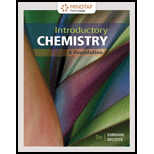
Concept explainers
(a)
Interpretation:
Complete and balance the given
Concept Introduction:
Compounds consist of carbon and hydrogen is known as hydrocarbons. Hydrocarbons are classified as saturated hydrocarbon and unsaturated hydrocarbon. Saturated hydrocarbons are those hydrocarbons in which carbon-carbon single bond is present as carbon is linked with four atoms.
The reaction in which burning of hydrocarbons takes place in oxygen to release water and carbon dioxide is known combustion reaction of hydrocarbon.
Answer to Problem 38QAP
Explanation of Solution
The complete reaction is shown below:
Now, balance the above reaction, number of carbon atom is 3 on reactant side and on product side number of carbon atom is 1. Similarly, number of hydrogen atom is 18 on reactant side and on product side number of hydrogen atom is 2. Number of oxygen atom is 2 on reactant side and on product side number of oxygen atom is 3.
To balance the reaction, multiply
Thus, number of carbon atoms, oxygen atoms and hydrogen atoms are equal on both sides of the reaction.
(b)
Interpretation:
Complete and balance the given chemical reaction.
Concept Introduction:
Compounds consist of carbon and hydrogen is known as hydrocarbons. Hydrocarbons are classified as saturated hydrocarbon and unsaturated hydrocarbon. Saturated hydrocarbons are those hydrocarbons in which carbon-carbon single bond is present as carbon is linked with four atoms. Unsaturated hydrocarbons are those hydrocarbons in which carbon-carbon multiple bonds are present that is double and triple bond.
Substitution reactions are those reactions in which or more hydrogen atoms are replaced by other atoms such as halogen.
Answer to Problem 38QAP
Explanation of Solution
The complete reaction is given as:
Above reaction is the second step of successively reaction of methane with chlorine (one hydrogen atom is replaced by chlorine atom). Here, stands for ultraviolet light which is required to break the bond between (Cl2 ) two chlorine atoms and from two chlorine radicals.
Now, balance the above reaction, number of carbon atom is 1 on reactant side and on product side number of carbon atom is 1. Similarly, number of hydrogen atom is 3 on reactant side and on product side number of hydrogen atom is 3. Number of chlorine atom is 3 on reactant side and on product side number of chlorine atom is 3.
Thus, reaction is already balanced.
Thus, number of carbon atoms, chlorine atoms and hydrogen atoms are equal on both sides of the reaction.
(c)
Interpretation:
Complete and balance the given chemical reaction.
Concept Introduction:
Compounds consist of carbon and hydrogen is known as hydrocarbons. Hydrocarbons are classified as saturated hydrocarbon and unsaturated hydrocarbon. Saturated hydrocarbons are those hydrocarbons in which carbon-carbon single bond is present as carbon is linked with four atoms. Unsaturated hydrocarbons are those hydrocarbons in which carbon-carbon multiple bonds are present that is double and triple bond.
Substitution reactions are those reactions in which or more hydrogen atoms are replaced by other atoms such as halogen.
Answer to Problem 38QAP
Explanation of Solution
The complete reaction is given as:
Above reaction is the last step of successively reaction of methane with chlorine (all the hydrogen atoms are replaced by chlorine atoms). Here, stands for ultraviolet light which is required to break the bond between (Cl2 ) two chlorine atoms and from two chlorine radicals.
Now, balance the above reaction, number of carbon atom is 1 on reactant side and on product side number of carbon atom is 1. Similarly, number of hydrogen atom is 1 on reactant side and on product side number of hydrogen atom is 1. Number of chlorine atom is 5 on reactant side and on product side number of chlorine atom is 5.
Thus, reaction is already balanced.
Thus, number of carbon atoms, chlorine atoms and hydrogen atoms are equal on both sides of the reaction.
Want to see more full solutions like this?
Chapter 20 Solutions
Introductory Chemistry
- Synthesize 2-Ethyl-3-methyloxirane from dimethyl(propyl)sulfonium iodide using the necessary organic or inorganic reagents. Draw the structures of the compounds.arrow_forwardSynthesize 2-Hydroxy-2-phenylacetonitrile from phenylmethanol using the necessary organic or inorganic reagents. Draw the structures of the compounds.arrow_forwardSynthesize N-Methylcyclohexylamine from cyclohexanol using the necessary organic or inorganic reagents. Draw the structures of the compounds.arrow_forward
- Synthesize N-Methylcyclohexylamine from cyclohexanol using the necessary organic or inorganic reagents. Draw the structures of the compounds.arrow_forwardIf possible, please provide the formula of the compound 3,3-dimethylbut-2-enal.arrow_forwardSynthesize 1,4-dibromobenzene from acetanilide (N-phenylacetamide) using the necessary organic or inorganic reagents. Draw the structures of the compounds.arrow_forward
- Indicate the products obtained by mixing (3-oxo-3-phenylpropyl)triphenylphosphonium bromide with sodium hydride.arrow_forwardWe mix N-ethyl-2-hexanamine with excess methyl iodide and followed by heating with aqueous Ag2O. Indicate the major products obtained.arrow_forwardIndicate the products obtained by mixing acetophenone with iodine and NaOH.arrow_forward
- Indicate the products obtained by mixing 2-Propanone and ethyllithium and performing a subsequent acid hydrolysis.arrow_forwardIndicate the products obtained if (E)-2-butenal and 3-oxo-butanenitrile are mixed with sodium ethoxide in ethanol.arrow_forwardQuestion 3 (4 points), Draw a full arrow-pushing mechanism for the following reaction Please draw all structures clearly. Note that this intramolecular cyclization is analogous to the mechanism for halohydrin formation. COH Br + HBr Brarrow_forward
 Chemistry: The Molecular ScienceChemistryISBN:9781285199047Author:John W. Moore, Conrad L. StanitskiPublisher:Cengage Learning
Chemistry: The Molecular ScienceChemistryISBN:9781285199047Author:John W. Moore, Conrad L. StanitskiPublisher:Cengage Learning Chemistry: An Atoms First ApproachChemistryISBN:9781305079243Author:Steven S. Zumdahl, Susan A. ZumdahlPublisher:Cengage Learning
Chemistry: An Atoms First ApproachChemistryISBN:9781305079243Author:Steven S. Zumdahl, Susan A. ZumdahlPublisher:Cengage Learning Chemistry for Engineering StudentsChemistryISBN:9781337398909Author:Lawrence S. Brown, Tom HolmePublisher:Cengage Learning
Chemistry for Engineering StudentsChemistryISBN:9781337398909Author:Lawrence S. Brown, Tom HolmePublisher:Cengage Learning General Chemistry - Standalone book (MindTap Cour...ChemistryISBN:9781305580343Author:Steven D. Gammon, Ebbing, Darrell Ebbing, Steven D., Darrell; Gammon, Darrell Ebbing; Steven D. Gammon, Darrell D.; Gammon, Ebbing; Steven D. Gammon; DarrellPublisher:Cengage Learning
General Chemistry - Standalone book (MindTap Cour...ChemistryISBN:9781305580343Author:Steven D. Gammon, Ebbing, Darrell Ebbing, Steven D., Darrell; Gammon, Darrell Ebbing; Steven D. Gammon, Darrell D.; Gammon, Ebbing; Steven D. Gammon; DarrellPublisher:Cengage Learning ChemistryChemistryISBN:9781305957404Author:Steven S. Zumdahl, Susan A. Zumdahl, Donald J. DeCostePublisher:Cengage Learning
ChemistryChemistryISBN:9781305957404Author:Steven S. Zumdahl, Susan A. Zumdahl, Donald J. DeCostePublisher:Cengage Learning





